|
| Hort& Crop
Science Home | Site Index |

|
|
|
|
|
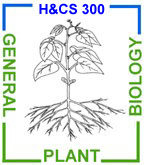
|
SIGNALS & SENSORS
|
|

Gravity
receptors
|
|
In order to detect gravity plant cells must contain
amyloplasts (also called
"statoliths" in this context). These are heavier than the
cytoplasm and tend to settle out under gravity. When they
touch the endoplasmic reticulum some kind of signal is
generated that results in correction of growth. Usually this
means positive geotropism (or growth in response to gravity)
in roots and negative geotropism in shoots.
|
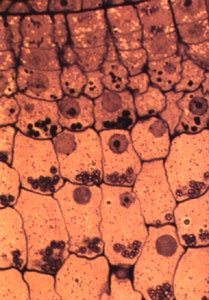
Section of pea root, showing statoliths settled at bottom of
cells
|
|
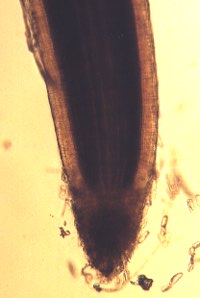
Secale root tip stained with iodine showing starch in
columella of root cap
|
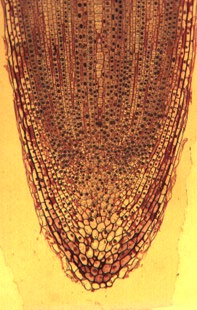
Allium root cap, showing columella.
|
|
Light receptors
The best known photoreceptor in plants is
phytochrome, a pigmented protein that exists in two
forms:
- Pr absorbs red light (660nm) and then is converted to
Pfr
- Pfr absorbs far-red light (730 nm) and is converted
back to Pr
|
|
Phytochrome is synthesized as Pr which is physiologically
inactive. Pfr is the physiologically active form of
phytochrome and apart from conversion to Pr in far red
light, it is lost in the dark either by slow reversion to Pr
or by degradation of the protein itself.
|
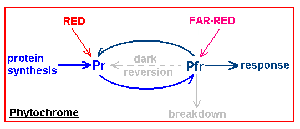
|
|
Many plant developmental processes are regulated by
phytochrome, whereas growth responses are often regulated by
a blue-light absorbing pigment, sometimes called
cryptochrome. Shoots are usually positively
phototropic whereas roots are negatively phototropic.
|
|
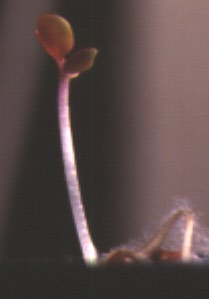
Brassica rapa seedling grown in dark
|
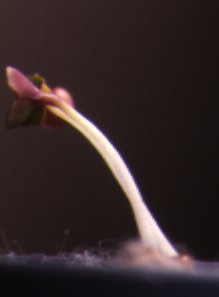
similar seedling grown in weak blue light from left
|
|
Auxin and tropisms
Growth responses to light and gravity are thought to involve
changes in the concentration of IAA. IAA, coming from the
stem apex, accumulates on the side of the organ away from
the light or on the same side as the gravity stimulus.
Because auxin stimulates shoot elongation, but inhibits root
elongation this leads to unequal growth on the two sides of
the structure and hence curvature.
|
|
This is the basis of the Cholodny-Went hypothesis of the
mechanism of plant tropic responses, which is not
universally accepted although it has been the subject of
much research over the past 50 years.
|
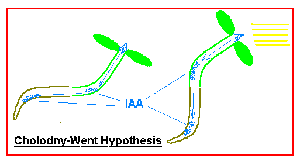
|
|
Biological clock
Evidence of time-keeping is found amongst all groups of
eukaryotes from single-celled protists to
complex-multicellular organisms. Plants are no exception to
this general rule but we do not understand how time is
recorded. As in most organisms, the typical clock cycle is
about a 24 hours, which leads to the term"circadian" in
relation to rhythms of plant movement, metabolism or growth.
Some features of the clock in plants are:
- it is set or"entrained" by daily light-dark
cycles.
- phytochrome is involved in setting the clock
- rhythms die away in continuous light or dark
- the clock runs at the same speed whether it is warm
or cold
|
|

So called"endogenous rhythms" are most readily seen
among plants that close their leaves or flowers at night.
Once the rhythm is set up or entrained it will continue for
several cycles in total darkness. There are also diurnal
cycles of plant growth (most plants grow mainly at night)
and more subtle changes such as enzyme activity.
Mechanical stimulation
Some plants such as the senstive plant Mimosa pudica
have obvious responses to touch or other mechanical
stimulation. However, the growth of all plants is affected
by mechanical stresses such as wind, trampling or brushing
against other objects (animal, vegetable or mineral) Of
course plants have no nervous system and it is not clear how
they perceive these stimuli. Electrical signals seem to be
involved, just as they are with nerve cells. Plants under
mechanical stress usually produce more ethylene than
unstressed plants, and since ethylene inhibits stem
elongation it may be involved in the growth response of
plants.
|
|
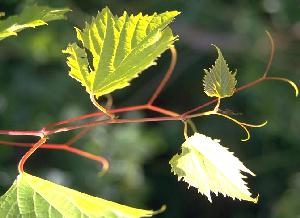
One of the best places to see plant response to touch or
thigmotropism is in the tendrils of climbing plants
such as Vitis. Gentle stroking of one side of a
tendril will induce curvature towards that side in a matter
of hours
|
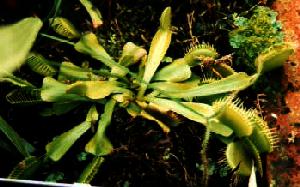
Leaves of the insectivorous venus' fly trap (Dionaea
muscipula) respond to touch by closing over their
prey
|
|
Internal stresses
The thickening of horizontal stems (reaction wood in trees)
is a response to a kind of mechanical stress. In this case
the stress is generated by the weight of the plant
itself.
At the cell level sensing and adjustment to the pressure
of the plasma membrane on the cell wall is a necessary part
of the cell's water relations. There seem to be
pressure-sensing proteins in the cell wall so that water
potentials inside and outside the cell and the elasticity of
the cell wall can be balanced. The growing cell needs turgor
pressure but avoids excessive turgor that would burst the
cell wall.
Temperature
Plants respond directly to the effects of temperature on the
rates of chemical reactions. They have mechanisms to cope
with extremes of temperature, heat and cold. Processes such
as seed germination, bud break, and flower initiation often
require a period of cold, especially in temperate zone
plants. We usually expect processes to be promoted by high
temperature and it is not clear how cold exposure is
perceived or translated into a positive signal.
|
|
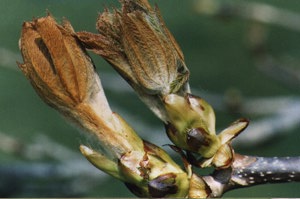
Aesculus hippocastanum (Horse chestnut)
|
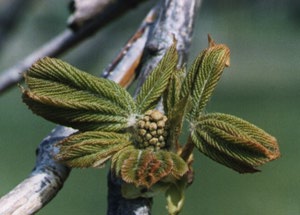
|
|

QUIZ

| Hort& Crop
Science Home | Site Index |

Copyright © Michael Knee, The Ohio State
University
All rights reserved.
|